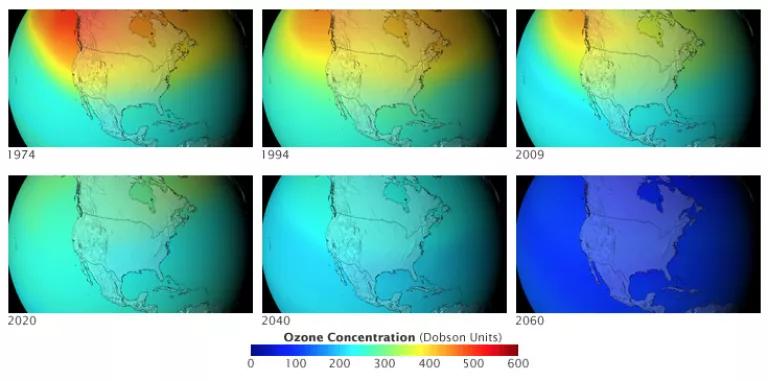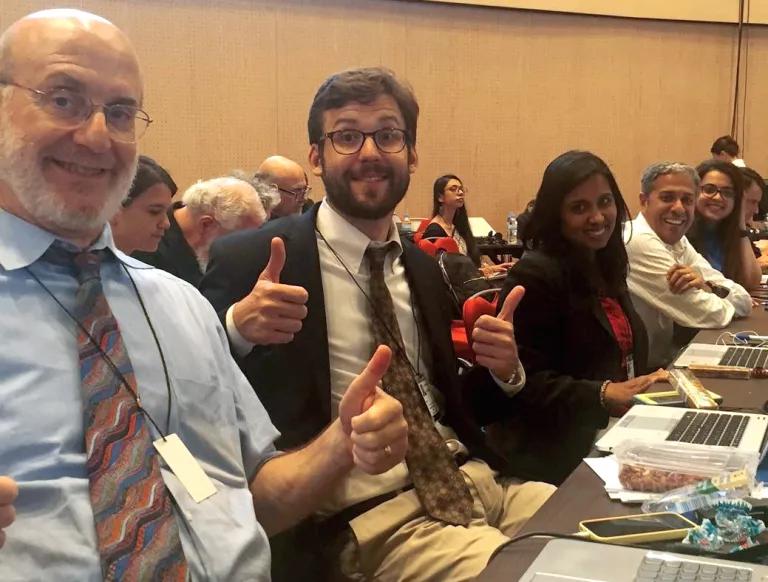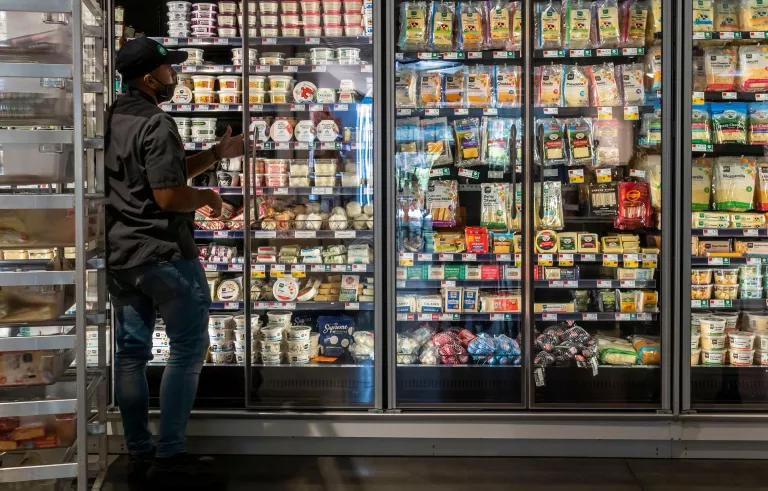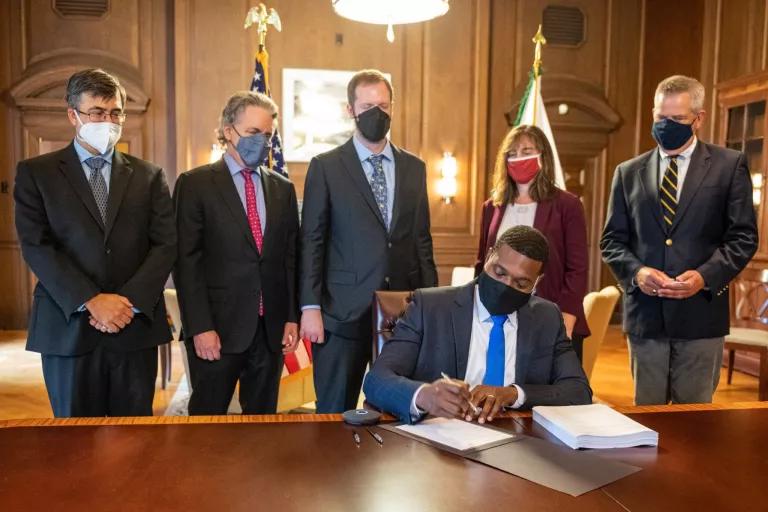The United States Finally Joins a Global Climate Treaty That Phases Down HFCs
How NRDC leadership helped pass the Kigali Amendment and turn the tide on a common class of super-polluting refrigerant chemicals.

Members of the organizing committee applauding the adoption of the Kigali Amendment, October 15, 2016
They may not be as high-profile as the greenhouse gases carbon dioxide or methane, but hydrofluorocarbons (HFCs) have long spelled similar disaster for the climate.
HFCs are the manmade chemicals commonly used in air conditioners, refrigerators, insulating foams, and other applications. But when they leak into the air, they pack hundreds—even thousands—of times the heat-trapping punch of carbon dioxide.
Climate scientists began sounding the alarm on HFCs more than a decade ago, warning that if we let them keep increasing, these pollutants could raise global temperatures by as much as half a degree Celsius by 2100.
Remarkably, and in a rare display of global coordination on climate action, world leaders listened and agreed to phase them down. And this October, the United States formally ratified the Kigali Amendment, an international climate treaty that commits the 145 participating countries to reducing total HFC production 80 to 85 percent by the late 2040s. The treaty amends the famously successful Montreal Protocol, which phased out chlorofluorocarbons (the precursors to HFCs) and is credited with saving the once-deteriorating ozone layer.
The global agreement—backed by environmental and industry groups as well as lawmakers on both sides of the aisle—is the culmination of more than a decade of diplomacy, policymaking, and advocacy. It was shaped at every step of the way by NRDC leadership and expertise.
The success of the Montreal Protocol
Before climate change dominated environmental news, another atmospheric disaster loomed in the skies—a disintegrating ozone layer.
In 1974, scientists made the shocking discovery that chlorofluorocarbons (CFCs)—used in everything from aerosol sprays to air conditioners—reacted with ultraviolet (UV) radiation from the sun to degrade ozone in the stratosphere. (Ozone is a thin shield that prevents much of the sun’s UV radiation from reaching the earth’s surface.) While that news led to significant change—aerosol sales dropped and some companies quickly redesigned products—the chemical manufacturing industry stood its ground, denying the science and attacking the chemists who’d raised the red flags.
NRDC was the leading environmental group fighting back. We continued to elevate the research to lawmakers and the public while pushing for bans on ozone-depleting chemicals, both domestically and internationally. When action stalled under the Reagan administration, NRDC lawyers sued the U.S. Environmental Protection Agency (EPA) to compel it to act on its findings that CFCs endangered public health.

It worked: In 1987, countries came together and signed the Montreal Protocol, which began phasing out production of CFCs from the marketplace and replaced them with readily available, safer alternatives. By mending the ozone layer and sparing the planet the additional UV radiation, the Montreal Protocol is saving millions of lives and preventing hundreds of millions of cases of skin cancer in the United States alone. Agricultural crops, forests, and creatures large and small were also spared. Today, every country is a party to the protocol, making it the “world’s most successful environmental treaty,” says NRDC’s chief global warming lawyer, David Doniger, who joined NRDC in 1978 and was instrumental in shaping the treaty. The ozone layer is now expected to make a full recovery by the second half of this century.
The planet-warming replacements for CFCs
As successful as the Montreal Protocol continues to be, the HFCs that replaced ozone-depleting CFCs in air conditioners and refrigerators weren’t perfect. HFCs don’t harm the ozone layer and are less potent greenhouse gases than CFCs, but they still contribute to climate change.
“A lot of the people who tell this story say, ‘Uh-oh, we traded one problem for another,’ but actually, we moved in the right direction on both the ozone and climate problems,” Doniger says. “In addition to saving the ozone layer, eliminating CFCs remains the single-biggest step countries have taken so far to slow climate change.”
But as global production of HFCs grew, it became clear that more climate-friendly alternatives needed to be found. NRDC experts were among the first to push for that next phase of progress.
The road to the Kigali Amendment
Because of their impact on climate change, there was an attempt to address HFCs by including them in early climate agreements. But making progress via those treaties proved tricky because any major push for climate action was stiffly opposed by fossil fuel interests. Plus, Doniger says that in the climate talks, “CO2 sucked all the oxygen out of the room,” making it difficult to get any attention on HFCs.
So the strategy changed. In 2008, Doniger proposed shifting responsibility for HFCs from the climate treaties to the Montreal Protocol, and phasing down global HFC production in the same way we’d handled CFCs. Countries took up the idea, proposing HFC phasedown plans in 2009: One proposal came from a group of island countries and another from Canada, Mexico, and the United States. The debate over these made slow but steady progress in the years that followed.
During that time, NRDC continued to be the lead environmental group pushing these talks forward. Alex Hillbrand, an engineer and HFC expert, joined NRDC in 2015 and added more technical expertise to the team. He soon developed a computer tool that compared the environmental benefits of different phasedown strategies and timelines. Then he made it available to all countries. NRDC’s India team also joined other NRDC colleagues on a U.S.-India task force. They worked closely with Indian officials and industry to help address their specific concerns and build buy-in for what would become the Kigali Amendment. “Given the expected exponential growth of India’s cooling needs, their participation was critical,” says Prima Madan, senior advocate with NRDC’s India team.

These efforts paid off. On October 15, 2016, in the Rwandan capital of Kigali, more than 100 countries agreed to adopt the Kigali Amendment to the Montreal Protocol. A product of nearly a decade of diplomacy and negotiations, it would reduce global HFC levels between 80 and 85 percent by 2047, with developed countries taking the lead. The result of that is the equivalent of zeroing out the entire world’s heat-trapping pollution for two years. NRDC’s team was on the ground for the all-nighter to push for the amendment’s final adoption and celebrate in the wee hours of the morning.
Dozens of countries moved quickly to ratify the new climate deal. In the United States, however, Donald Trump was elected president just two months after Kigali was adopted. He did not send the deal to the Senate for approval.
The U.S. strategy shifts
After ratification of the Kigali Amendment by the United States became a long shot, NRDC regrouped.
Even before Kigali’s signing, NRDC had been working to adopt domestic HFC regulations under the Clean Air Act. “The United States needed to get started on HFCs so we would have credibility in the world on Kigali,” Hillbrand says. Those rules were adopted before the Trump administration took office, but that effort hit a second roadblock in 2017 when a federal court ruled that the Clean Air Act didn’t give EPA the necessary authority to regulate HFCs.

So NRDC turned to the states. In 2018, we launched a campaign with the HFC team’s newest policy advocate for the Climate & Clean Energy Program, Christina Theodoridi, at the helm. Theodoridi and her colleagues pressed for HFC limits at the state level that the federal court had blocked the EPA from adopting at the federal level. In some cases, that resulted in new regulations under existing laws, and in others, it required passing new laws. “There was palpable momentum,” says Theodoridi. “States were eager to take action at a time when the federal government was lagging.”
While this was great news for the climate and public health, having different state-level regulations on HFCs wasn’t ideal for chemical companies and appliance makers, which preferred regulatory consistency. “It was a huge headache for them,” Doniger says. “Industry began to think they’d be much better off with federal legislation.”
Momentum from an unexpected alliance
In addition to satisfying the industry’s desire for more consistent rules, a nationwide phasedown of HFCs also fit its business plans. The same companies that produce and use HFCs had already developed (and patented) more climate-friendly alternatives, including hydrofluoroolefins (HFOs), which do not last as long in the atmosphere and have less heat-trapping power. “They were getting ready to implement Kigali before the 2016 election,” Doniger says, “and they chose to stay the course.” Unlike the fossil fuel industry, which continues to fight climate legislation tooth and nail, the chemical and appliance manufacturers were more willing to evolve because they saw a financial pathway forward in making alternative refrigerants.

So NRDC worked with them to craft federal HFC legislation called the American Innovation and Manufacturing (AIM) Act, which was proposed in 2020 and cosponsored by senators and representatives from both parties. With support from a strange bedfellows coalition, the AIM Act proved politically viable. High-profile industry groups, including the U.S. Chamber of Commerce and the American Chemistry Council, joined NRDC in pushing the bill forward, and it was enacted on a bipartisan basis at the end of 2020. The law mandates a U.S. phasedown in line with the Kigali Amendment, reducing as much climate pollution in 15 years as taking one in every seven cars off the road. Its passage marked the biggest win for climate during the Trump administration.
Kigali ratification—and cooling in a warmer world
At the start of 2021, the political climate shifted again. With the Biden administration in office, climate was back on the agenda.
NRDC led the regulatory effort to implement the new AIM Act. We pushed the EPA to: supplement the HFC production phasedown with regulations to ban HFCs from new products where safer alternatives were already available; stop preventable HFC leakage to the atmosphere; and reclaim and reuse existing HFCs in place of making new ones.
Then, in October 2022, after a six-year delay, the U.S. Senate voted 69 to 27 to finally ratify the Kigali Amendment. In a sight rarely seen in Washington, D.C., industry and environmental groups, as well as lawmakers on both sides of the aisle, celebrated the monumental climate win.
The United States now joins 145 countries as parties to the worldwide HFC phasedown. That is particularly positive news since the United States, China, and India are three of the largest producers and consumers of HFCs. In India’s case, NRDC’s India team and its partners were especially critical in helping shape the country’s strong commitments.
NRDC’s hard-won victories on HFCs, both domestically and on the world stage, have come just in time. By 2050, it’s estimated that the world will need 4.5 billion air conditioners to stay cool—four times the number we have now—all of which will rely on refrigerant gases.
That means the urgency to improve the energy efficiency of air conditioners sits front and center. Climate advocates will also continue to press for complementary solutions, such as installing low-tech “cool roofs” in urban centers and implementing regional heat action plans to help bring relief to residents suffering the impacts of increasingly commonplace heat waves. “We live in a warming world—and we live in a world where most of the Global South and tropics have way too little access to cooling for health and economic prosperity,” Hillbrand says. “Universal cooling access remains a huge development need.” But if the fight to ditch HFCs teaches any lessons, it’s that global coordination on climate is possible.
This NRDC.org story is available for online republication by news media outlets or nonprofits under these conditions: The writer(s) must be credited with a byline; you must note prominently that the story was originally published by NRDC.org and link to the original; the story cannot be edited (beyond simple things such as grammar); you can’t resell the story in any form or grant republishing rights to other outlets; you can’t republish our material wholesale or automatically—you need to select stories individually; you can’t republish the photos or graphics on our site without specific permission; you should drop us a note to let us know when you’ve used one of our stories.

1.5 Degrees of Global Warming—Are We There Yet?
Public Health Scientist and Advocate
Climate Change Is In the Air
1.5 Degrees of Global Warming—Are We There Yet?
Public Health Scientist and Advocate
Climate Change Is In the Air
1.5 Degrees of Global Warming—Are We There Yet?
Public Health Scientist and Advocate
Climate Change Is In the Air
1.5 Degrees of Global Warming—Are We There Yet?
Public Health Scientist and Advocate